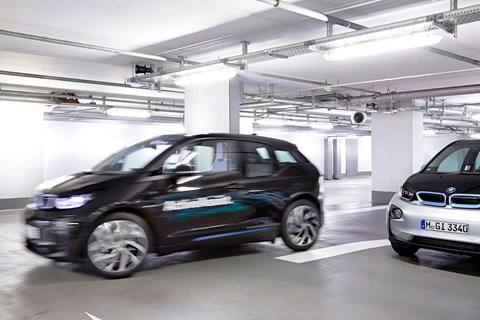► The latest tech on test
► Park your car by app
► But does it actually work?
Does anyone actually enjoy parking? The fear of dinged alloy wheels, the worry of panels scraped by multi-storey concrete pillars and dented doors from careless neighbouring cars make it a worry for motorists of all persuasions.
Help is at hand in the shape of clever tech being pioneered by the likes of BMW and Volvo, or rather their giant suppliers such as Bosch and Valeo. The big game in town is developing software that marries data from existing sensors with the nascent autonomous systems appearing on more and more connected cars. Side benefits? Cars that can park themselves.
We’ve tried Bosch’s prototype system at the firm’s Boxberg proving ground in Germany, parking a VW Passat from an iPhone. It’s an unnerving experience, as you step out of the car and call up the parking app. Remember Pierce Brosnan remote driving his 7-series by cellphone in Tomorrow Never Dies? That was 17 years ago; now reality is catching up.
Fully automated parking uses data from parking sensors to make sure the coast is clear; this is then fed into a computer to calculate the best route into a space – and thanks to electric power steering, the wheels are twirled with millimetric precision. There’ll be no excuse for not parking straight again.
You are merely a failsafe observer in the parking manoeuvre, as the car controls throttle and steering for you. It’s easy to see how this could be useful in narrow spaces today, or by packing more cars into smaller lot space, but the real win comes in future when cars are borrowed. Imagine stepping off the train and calling up the nearest available city car to drive to your next appointment.
Bosch is working with the University of Oxford to perfect this system, which is set to be released before the end of the decade. It’s like Uber for those who prefer to drive – but not necessarily park.
Did it work?
Yes… Parking your car from your iPhone or Apple watch might seem like tech overkill today, but it’ll make sense in a multi-modal future when you borrow an EV to drive into town.

4 steps to self-parking
1) The basics
Today’s cars can already twirl the wheel for you. The next generation will drive the last mile and parallel- or reverse-park for you – by app control
2) The all-seeing eye
Climb out, tap your phone and car reserves nearest free space. Sat-nav, cameras, lidar and ultrasonic sensors map out bump-free route

3) Look: no hands!
Data from sensors in road infrastructure and onboard systems crosschecked to apply steering, throttle, brakes to drive to bay
4) Park perfectly each time
Car pulls into the allocated space, switches off and locks doors. Inductive charging allows for wireless top-up
Click here for more CAR Tech stories
